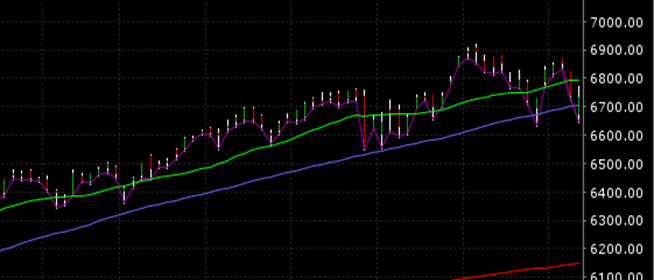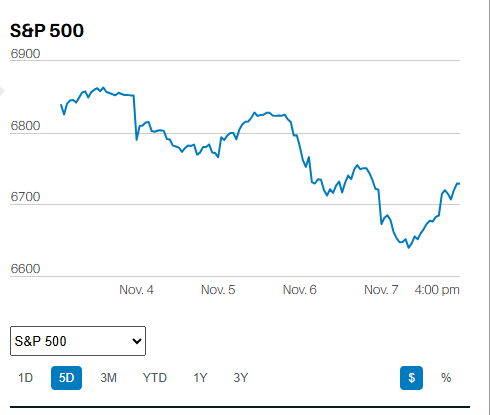Rising Investment Risk- check your portfolio allocations

Market Update
The S&P 500 rose 1.8% last week to finish at 4471.37. The index is down 1.0% since Labor Day. Markets can correct in time as well as price. The S&P did fall 5.2% from September 2nd to October 4th and hasn’t set a new high in six weeks. Now it has moved back above its 50-day moving average after spending three weeks below it. The climb above the 50-day opens the way for further upside testing. It is possible that the six-week pause will serve as a springboard to higher prices. Earnings season is here, and results will help determine the stock market’s near-term path.
The Conference Board is forecasting third-quarter GDP growth of 3.6%. The Atlanta Fed’s GDPNow forecast is calling for 1.2% growth. Yet earnings season is off to a good start despite the expected slowdown in economic growth. Barron’s Big Money Poll is out and nearly 80% of respondents expect a stock market correction in the next six months. Yet most Big Money respondents also see the bull market continuing. Only 12% of respondents are bearish. The other 88% are either bullish or neutral.
The stock market has a distinct bullish bias heading into year-end. The market is not likely to run into trouble in November and December. The one caveat is the Federal Reserve. It meets in early November. The market will react poorly if the Fed announces a more aggressive tapering timeline than expected. Otherwise, it isn’t likely we’ll see much selling into year-end. There are a few weeks left in October and earnings season to get through first, however.
Economic Update
The median expected three-year inflation rate rose to 4.2% from 4.0%, according to MarketWatch. The 5-year breakeven inflation rate is 2.71%. The 10-year breakeven inflation rate is 2.56%. The breakeven rates indicate bond investors' anticipated inflation rate. Inflation is somewhat of a self-fulfilling prophecy. Inflation is more likely to materialize if people are expecting it. A demand for higher wages to offset expected inflation is a major transmission mechanism.
The Core CPI rose 0.2% in September. The headline number was up 0.4%. Both were 0.1% higher than the prior month. The year-over-year rise in the CPI was 5.4% in September, the fastest rise since before 1990, according to Barron’s. There is a growing debate about whether the uptick in inflation is transitory or more permanent. The Atlanta Fed tracks both “Sticky” and “Flexible” CPI measures. "Sticky" CPI measures a basket of goods and services less sensitive to the economic cycle. "Flexible" CPI measures a basket of goods and services more sensitive to the economic cycle. "Flexible” CPI has risen to over 13%, reflecting a rapid increase in energy costs primarily. The “Flexible” measure hasn’t been as high since the early 1980s. The “Sticky” CPI is starting to rise as well. It is up 2.8%, which is a 13-year high. The “Sticky” measure includes housing costs, which are starting to rise. Of course, housing prices have skyrocketed in the real world. But the Federal Reserve uses Owners’ Equivalent Rent in the CPI. It tends to lag price movements in housing by a year or so.
The jury is out on transitory versus more permanent inflation. The Federal Reserve has stuck to its view that inflation will begin to subside next year on its own. It continues to signal that it doesn't expect to raise interest rates anytime soon. The next two to three quarters will tell the tale. Subsiding inflation will allow the Fed to hold off on any aggressive interest rate hikes. A continued rise in inflation will likely force its hand. A continued rise may even force the Fed to play catch up, something that always ends in tears for the stock market.
Rising Investment Risk
Bank of America is forecasting an interest rate shock in 2022. It believes the Federal Reserve will be forced to raise rates sooner and more aggressively than currently expected. According to BofA, policymakers and politicians are increasingly worried that inflation will damage growth and approval ratings. BofA thinks policymakers will pivot from pro-growth policies to anti-inflation policies. The bank points to looming U.S. monetary and fiscal cliffs as $8.4 trillion in emergency stimulus by the Federal Reserve and Treasury comes to an end. BofA points out that global tapering is already happening. Central bank liquidity measures will drop to around $100 billion in 2022 from $2.1 trillion in 2021 and $8.5 trillion in 2020.
Regardless of whether Bank of America is right in the details, it is right in the direction. Global liquidity is starting to dry up. Developed countries, particularly the U.S., are preparing to ease off the emergency measures. Reducing emergency measures is tightening. Hiking interest rates and reducing the growth in the fiscal budget is additional tightening. It is almost a guarantee at this point that both forms of tightening are looming in the next 12 to 18 months. Investing in both stocks and bonds is the riskier for it.
Investors would do well to check their portfolio allocations, making sure they are comfortable with the amount of risk they are taking. Now is not the time to be chasing returns without understanding the potential costs should markets stumble as monetary and fiscal policies shift.
Regards,
Christopher R Norwood, CFA
Chief Market Strategist











